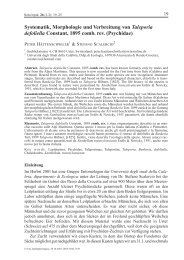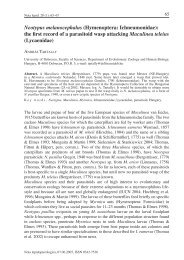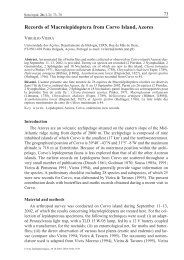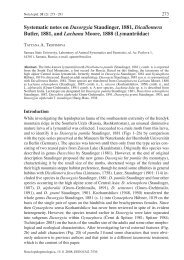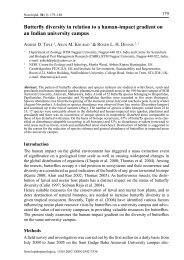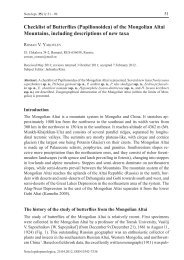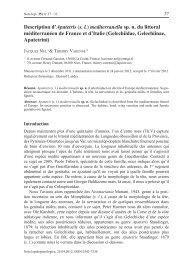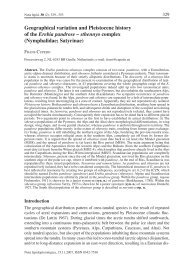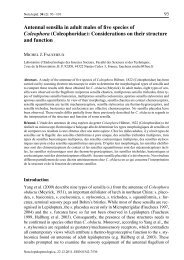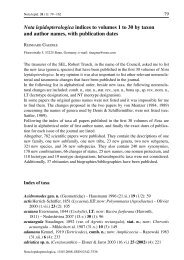Improving the knowledge on Romanian Rhopalocera, including the ...
Improving the knowledge on Romanian Rhopalocera, including the ...
Improving the knowledge on Romanian Rhopalocera, including the ...
You also want an ePaper? Increase the reach of your titles
YUMPU automatically turns print PDFs into web optimized ePapers that Google loves.
Nota lepid. 31 (1): 3 – 23<br />
<str<strong>on</strong>g>Improving</str<strong>on</strong>g> <str<strong>on</strong>g>the</str<strong>on</strong>g> <str<strong>on</strong>g>knowledge</str<strong>on</strong>g> <strong>on</strong> <strong>Romanian</strong> <strong>Rhopalocera</strong>,<br />
<strong>including</strong> <str<strong>on</strong>g>the</str<strong>on</strong>g> rediscovery of Polyommatus amandus<br />
(Schneider, 1792) (Lycaenidae) and an applicati<strong>on</strong><br />
of DNA-based identifi cati<strong>on</strong><br />
VLAD DINCĂ 1 & ROGER VILA 2<br />
1 Departament de Genètica i Biologia Molecular, Universitat Autònoma de Barcel<strong>on</strong>a,<br />
Bellaterra, Barcel<strong>on</strong>a, Spain; e-mail: sudistu@yahoo.com<br />
2 ICREA and Departament de Genètica i Biologia Molecular, Universitat Autònoma de Barcel<strong>on</strong>a,<br />
Bellaterra, Barcel<strong>on</strong>a, Spain, e-mail: roger.vila@uab.cat<br />
Abstract. From May 19th to June 8th of 2007, <str<strong>on</strong>g>the</str<strong>on</strong>g> authors undertook lepidopterological research in<br />
29 localities in Romania, several of which are poorly or totally unstudied from a lepidopterological<br />
point of view. 105 taxa were identifi ed, out of which seven receive special attenti<strong>on</strong> in <str<strong>on</strong>g>the</str<strong>on</strong>g> text, with<br />
comments <strong>on</strong> <str<strong>on</strong>g>the</str<strong>on</strong>g>ir distributi<strong>on</strong>, ecology and c<strong>on</strong>servati<strong>on</strong> status. Polyommatus amandus (Schneider,<br />
1792) (Lycaenidae) is recorded for <str<strong>on</strong>g>the</str<strong>on</strong>g> fi rst time in Romania after 28 years. We provide <str<strong>on</strong>g>the</str<strong>on</strong>g> fi rst record<br />
from Muntenia for Cupido (Everes) decolorata (Staudinger, 1886) (Lycaenidae), and <str<strong>on</strong>g>the</str<strong>on</strong>g> third known<br />
<strong>Romanian</strong> locati<strong>on</strong> for Pseudophilotes bavius egea (Herrich-Schäffer, 1852) (Lycaenidae). Lepidoptera<br />
DNA-based identifi cati<strong>on</strong> was used for species identifi cati<strong>on</strong> based <strong>on</strong> larval stages. This technique<br />
c<strong>on</strong>fi rmed <str<strong>on</strong>g>the</str<strong>on</strong>g> discovery of Zerynthia polyxena ([Denis & Schiffermüller], 1775) (Papili<strong>on</strong>idae) in sou<str<strong>on</strong>g>the</str<strong>on</strong>g>rn<br />
Dobrogea and its rediscovery in <str<strong>on</strong>g>the</str<strong>on</strong>g> entire province after 80 years.<br />
Introducti<strong>on</strong><br />
Although <str<strong>on</strong>g>the</str<strong>on</strong>g> <strong>Romanian</strong> butterfl y fauna has been studied for more than 150 years (e.g.<br />
Fuss 1850; Franzenau 1852, 1856, 1859; Mann 1866), <str<strong>on</strong>g>the</str<strong>on</strong>g>re are still large gaps regarding<br />
<str<strong>on</strong>g>the</str<strong>on</strong>g> distributi<strong>on</strong> and c<strong>on</strong>servati<strong>on</strong> status of many of <str<strong>on</strong>g>the</str<strong>on</strong>g> species known to occur<br />
within <str<strong>on</strong>g>the</str<strong>on</strong>g> country’s territory. The newest versi<strong>on</strong> of <str<strong>on</strong>g>the</str<strong>on</strong>g> Catalogue of <str<strong>on</strong>g>the</str<strong>on</strong>g> <strong>Romanian</strong><br />
Lepidoptera (Rákosy et al. 2003) refl ects <str<strong>on</strong>g>the</str<strong>on</strong>g> <str<strong>on</strong>g>knowledge</str<strong>on</strong>g> for Romania’s main historical<br />
regi<strong>on</strong>s, which turn out to be very unequally studied, with <str<strong>on</strong>g>the</str<strong>on</strong>g> greatest gaps in <str<strong>on</strong>g>the</str<strong>on</strong>g><br />
sou<str<strong>on</strong>g>the</str<strong>on</strong>g>rn parts of <str<strong>on</strong>g>the</str<strong>on</strong>g> country. Moreover, a c<strong>on</strong>siderable amount of faunistical data was<br />
published decades ago and for many specifi c locati<strong>on</strong>s <str<strong>on</strong>g>the</str<strong>on</strong>g>re is no new data available<br />
<strong>on</strong> Lepidoptera, making an objective assessment of Romania’s species distributi<strong>on</strong> and<br />
c<strong>on</strong>servati<strong>on</strong> status very diffi cult. This is of particular importance now, as <str<strong>on</strong>g>the</str<strong>on</strong>g> country<br />
joined <str<strong>on</strong>g>the</str<strong>on</strong>g> European Uni<strong>on</strong> and c<strong>on</strong>servati<strong>on</strong>-oriented acti<strong>on</strong>s are more accessible (but<br />
also more necessary) than ever.<br />
The main goals of <str<strong>on</strong>g>the</str<strong>on</strong>g> present study are to improve <str<strong>on</strong>g>the</str<strong>on</strong>g> <str<strong>on</strong>g>knowledge</str<strong>on</strong>g> regarding <str<strong>on</strong>g>the</str<strong>on</strong>g><br />
<strong>Romanian</strong> butterfl y fauna and to point out <str<strong>on</strong>g>the</str<strong>on</strong>g> natural capital of several of <str<strong>on</strong>g>the</str<strong>on</strong>g> country’s<br />
areas, which are little known to European biologists. Special attenti<strong>on</strong> is given<br />
to seven taxa c<strong>on</strong>sidered of particular importance, <strong>including</strong> original distributi<strong>on</strong> data<br />
and aspects related to <str<strong>on</strong>g>the</str<strong>on</strong>g>ir c<strong>on</strong>servati<strong>on</strong> status. In additi<strong>on</strong>, Lepidoptera DNA-based<br />
identifi cati<strong>on</strong> is used as a means of precise species identifi cati<strong>on</strong> during larval development.<br />
Nota lepidopterologica, 15.05.2008, ISSN 0342-7536<br />
3
4 DINCĂ & VILA: On <strong>Romanian</strong> butterfl ies<br />
Abbreviati<strong>on</strong>s<br />
bp base pairs<br />
CI c<strong>on</strong>sistency Index<br />
COI cytochrome oxidase subunit I<br />
COII cytochrome oxidase subunit II<br />
DNA deoxyrib<strong>on</strong>ucleic acid<br />
dNTP deoxynucleoside triphosphate<br />
HPLC high performance liquid chromatography<br />
MP maximum parsim<strong>on</strong>y<br />
PCR polymerase chain reacti<strong>on</strong><br />
RI retenti<strong>on</strong> Index<br />
RV Roger Vila<br />
TBR tree bisecti<strong>on</strong> rec<strong>on</strong>necti<strong>on</strong><br />
TL tree length<br />
tRNA-leu leucine-transfer rib<strong>on</strong>ucleic acid<br />
VD Vlad Dincă<br />
Material and methods<br />
Collecting. The fi eld research was undertaken in <str<strong>on</strong>g>the</str<strong>on</strong>g> interval May 19th – June 8th of<br />
2007 and covered various regi<strong>on</strong>s of Romania (Fig. 1). Most of <str<strong>on</strong>g>the</str<strong>on</strong>g> collecting was made<br />
using insect nets, but in several cases we also looked for preimaginal stages. When<br />
c<strong>on</strong>sidered necessary, we preserved material for DNA studies, in which case <str<strong>on</strong>g>the</str<strong>on</strong>g> insect<br />
body was kept in 100% ethanol vials, and <str<strong>on</strong>g>the</str<strong>on</strong>g> wings inside glassine envelopes as reference.<br />
All samples are stored in RV lab’s DNA and Tissues Collecti<strong>on</strong> at Universitat<br />
Autònoma de Barcel<strong>on</strong>a.<br />
Several specimens of Carcharodus, Pyrgus, Pieris, Leptidea and Melitaea where identifi<br />
ed through genitalia examinati<strong>on</strong>. The systematics used follows that of <str<strong>on</strong>g>the</str<strong>on</strong>g> Catalogue<br />
of <str<strong>on</strong>g>the</str<strong>on</strong>g> <strong>Romanian</strong> Lepidoptera (Rákosy et al. 2003), with <str<strong>on</strong>g>the</str<strong>on</strong>g> excepti<strong>on</strong> of <str<strong>on</strong>g>the</str<strong>on</strong>g> misspelled<br />
genus name Plebeius Kluk, 1780 that we replaced with <str<strong>on</strong>g>the</str<strong>on</strong>g> correct Plebejus according<br />
to Bálint et al. (2001).<br />
Specimen sequencing. Total genomic DNA was extracted using Chelex 100 resin,<br />
100-200 mesh, sodium form (Biorad), following <str<strong>on</strong>g>the</str<strong>on</strong>g> protocol of Walsh, Metzger and<br />
Higuchi (1991). The following samples were extracted: Zerynthia polyxena ([Denis<br />
& Schiffermüller], 1775), Romania, C<strong>on</strong>stanţa County, Canaraua Fetei, 22.v.2007,<br />
RVcoll.07-D023 (collected as last instar larva); Z. polyxena, Romania, Buzău County,<br />
Dănciuleşti, 20.v.2007, RVcoll.07-D396 (collected as last instar larva); Allancastria cerisyi<br />
ferdinandi Stichel, 1907, Romania, C<strong>on</strong>stanţa County, Canaraua Fetei, 23.v.2007,<br />
RVcoll.07-D031 (collected as adult).<br />
A 650 bp fragment at <str<strong>on</strong>g>the</str<strong>on</strong>g> 5’ end of <str<strong>on</strong>g>the</str<strong>on</strong>g> mitoch<strong>on</strong>drial gene cytocrome oxidase subunit<br />
I (COI) was amplifi ed by polymerase chain reacti<strong>on</strong> using <str<strong>on</strong>g>the</str<strong>on</strong>g> primers LCO 1490<br />
(5’ -GGTCAACAAATCATAAAGATATTGG-3’) (Folmer et al. 1994) and Nancy<br />
(5’ -CCCGGTAAAATTAAAATATAAACTTC-3’) (Sim<strong>on</strong> et al. 1994). Double-stranded<br />
DNA was amplifi ed in 25 µl volume reacti<strong>on</strong>s: 17.65 µl ultra pure (HPLC quality)<br />
water, 2.5 µl 10X buffer, 1 µl 100mM MgCl , 0.25 µl 100 mM dNTP, 1.2 µl of each<br />
2<br />
primer (10 mM) and 0.2 µl Taq DNA Polymerase (Bior<strong>on</strong>, GmbH). The typical <str<strong>on</strong>g>the</str<strong>on</strong>g>rmal
Nota lepid. 31 (1): 3 – 23<br />
Fig. 1. Studied locati<strong>on</strong>s from May 19th to June 8th of 2007. Letters for each locality refer to those in<br />
Appendix 1.<br />
cycling profi le, carried in a PTC-100 Peltier Thermal Cycler, was 95 °C for 60 sec<strong>on</strong>ds,<br />
44 °C for 60 sec<strong>on</strong>ds and 72 °C for 90 sec<strong>on</strong>ds, for 35 cycles. PCR products were purifi<br />
ed and sequenced by Macrogen Inc. (Seoul, Korea).<br />
Sequence analysis. The sequences were edited and aligned using Sequencher 4.2<br />
(Genecodes Corporati<strong>on</strong>, Ann Arbor, MI) and MacClade 4.05 (Maddis<strong>on</strong> & Maddis<strong>on</strong><br />
1992). The fragments were of equal length and alignments unambiguous. Primer sequences<br />
were cropped and missing data and ambiguities were designated by <str<strong>on</strong>g>the</str<strong>on</strong>g> letter<br />
“N”. All sequences were submitted to GenBank (codes EU667423 to EU667425).<br />
Available GenBank COI sequences overlapping with <str<strong>on</strong>g>the</str<strong>on</strong>g> fragment sequenced by<br />
us and bel<strong>on</strong>ging to Zerynthia (DQ351039, AF170870), Allancastria (AF170869,<br />
DQ351040 to DQ351043) and Buthanitis (DQ351036 to DQ351038) were included<br />
in our analysis. For details regarding <str<strong>on</strong>g>the</str<strong>on</strong>g>se samples, refer to Nazari et al. (2007). The<br />
three Buthanitis taxa were selected as outgroup and as root for our analysis, based <strong>on</strong><br />
<str<strong>on</strong>g>the</str<strong>on</strong>g> results of Nazari et al. (2007). The phylogenetic analyses of <str<strong>on</strong>g>the</str<strong>on</strong>g> DNA data was<br />
c<strong>on</strong>ducted in PAUP* 4.0b10 (Swofford 2001) under <str<strong>on</strong>g>the</str<strong>on</strong>g> maximum parsim<strong>on</strong>y (MP)<br />
criteri<strong>on</strong>. Heuristic searches were c<strong>on</strong>ducted for MP analysis with all characters equally<br />
weighted and under <str<strong>on</strong>g>the</str<strong>on</strong>g> TBR swapping algorithm with 10000 random additi<strong>on</strong> sequences.<br />
The parsim<strong>on</strong>y hypo<str<strong>on</strong>g>the</str<strong>on</strong>g>sis was evaluated by bootstrap analysis (Felsenstein<br />
1985) with 1000 pseudo replicates under <str<strong>on</strong>g>the</str<strong>on</strong>g> same parameters as <str<strong>on</strong>g>the</str<strong>on</strong>g> initial parsim<strong>on</strong>y<br />
searches, except for using 1000 random additi<strong>on</strong> sequences.<br />
5
6 DINCĂ & VILA: On <strong>Romanian</strong> butterfl ies<br />
Fig. 2. Last instar larva of Z. polyxena <strong>on</strong> Aristolochia<br />
clematitis at Canaraua Fetei, 22.v.2007. Photo<br />
V. Dincă.<br />
Results and discussi<strong>on</strong><br />
Zerynthia polyxena ([Denis &<br />
Schiffermüller], 1775) Fig. 2<br />
Material. 5 terminal instar larvae, Romania,<br />
C<strong>on</strong>stanţa county, Canaraua Fetei, 22.v.2007.<br />
Although this species has been recorded<br />
from various localities distributed across<br />
Romania (Rákosy et al. 2003), <strong>on</strong>ly two<br />
very old records exist from Dobrogea<br />
(south-eastern Romania) (Mann 1866<br />
–surroundings of Tulcea– and Fiebig<br />
1927 –locality not specifi ed). Therefore<br />
it was c<strong>on</strong>sidered to be possibly extinct<br />
in this regi<strong>on</strong> (Rákosy & Wieser 2000).<br />
Moreover, Z. polyxena was never recorded<br />
from <str<strong>on</strong>g>the</str<strong>on</strong>g> sou<str<strong>on</strong>g>the</str<strong>on</strong>g>rn part of <str<strong>on</strong>g>the</str<strong>on</strong>g> province,<br />
which is relatively well studied from a<br />
lepidopterological point of view (Rákosy<br />
& Székely 1996).<br />
During <str<strong>on</strong>g>the</str<strong>on</strong>g> spring of 2007, we managed to<br />
fi nd several larvae in sou<str<strong>on</strong>g>the</str<strong>on</strong>g>rn Dobrogea<br />
(Canaraua Fetei) (Fig. 2), which we tentatively<br />
attributed to Z. polyxena. The lar-<br />
vae were found feeding <strong>on</strong> Aristolochia clematitis L. (Aristolochiaceae) (which is well<br />
represented in <str<strong>on</strong>g>the</str<strong>on</strong>g> area) and were collected in order to be reared. A few days after collecting,<br />
<strong>on</strong>e larva manifested signs of disease and <str<strong>on</strong>g>the</str<strong>on</strong>g>refore it was preserved in 100%<br />
ethanol. The o<str<strong>on</strong>g>the</str<strong>on</strong>g>rs reached <str<strong>on</strong>g>the</str<strong>on</strong>g> stage of prepupa or pupa without problems and had<br />
to be transported by plane from Romania to <str<strong>on</strong>g>the</str<strong>on</strong>g> laboratory in Spain where <str<strong>on</strong>g>the</str<strong>on</strong>g> rearing<br />
process was to be c<strong>on</strong>tinued. During <str<strong>on</strong>g>the</str<strong>on</strong>g> fl ight, <str<strong>on</strong>g>the</str<strong>on</strong>g> luggage c<strong>on</strong>taining <str<strong>on</strong>g>the</str<strong>on</strong>g> larvae was<br />
severely damaged and <str<strong>on</strong>g>the</str<strong>on</strong>g> recipient with <str<strong>on</strong>g>the</str<strong>on</strong>g> larvae was lost.<br />
The area of Canaraua Fetei is well known for being <strong>on</strong>e of <str<strong>on</strong>g>the</str<strong>on</strong>g> few locati<strong>on</strong>s in Romania<br />
where A. cerisyi ferdinandi fl ies (Rákosy & Székely 1996), a species with quite variable<br />
larvae, sometimes fairly similar to Z. polyxena, which also uses A. clematitis as larval<br />
food plant. Fur<str<strong>on</strong>g>the</str<strong>on</strong>g>rmore, <str<strong>on</strong>g>the</str<strong>on</strong>g> lack of adult specimens might cast doubt <strong>on</strong> <str<strong>on</strong>g>the</str<strong>on</strong>g> record,<br />
especially in <str<strong>on</strong>g>the</str<strong>on</strong>g> eyes of some <strong>Romanian</strong> lepidopterists for whom <str<strong>on</strong>g>the</str<strong>on</strong>g> famous area of<br />
Canaraua Fetei is a “classical” place for A. cerisyi, but certainly not <strong>on</strong>e for Z. polyxena.<br />
As a matter of fact, doubts <strong>on</strong> <str<strong>on</strong>g>the</str<strong>on</strong>g> veracity of our record were expressed by some<br />
colleagues who bred larvae of A. cerisyi from Canaraua Fetei and noticed that some are<br />
similar to those of Z. polyxena. Therefore, in order to c<strong>on</strong>fi rm our record, we decided to<br />
use DNA-based methods as a tool for precise species identifi cati<strong>on</strong>. This was possible<br />
because of <str<strong>on</strong>g>the</str<strong>on</strong>g> larva preserved in ethanol (RVcoll.07-D023), for which a 650 bp COI<br />
mitoch<strong>on</strong>drial fragment was sequenced and compared to those of a sympatric A. cerisyi
Nota lepid. 31 (1): 3 – 23<br />
ferdinandi (RVcoll.07-D031) and a <strong>Romanian</strong> specimen of Z. polyxena (RVcoll.07-<br />
D396) from <strong>on</strong>e of <str<strong>on</strong>g>the</str<strong>on</strong>g> closest known populati<strong>on</strong>s (Buzău county, Dănciuleşti – about<br />
150 km far). The putative Z. polyxena sample from Dobrogea presented an uncorrected<br />
“p” distance of <strong>on</strong>ly 0,15% (1 base-pair difference in a 650 bp fragment) compared to<br />
Z. polyxena from Dănciuleşti. On <str<strong>on</strong>g>the</str<strong>on</strong>g> o<str<strong>on</strong>g>the</str<strong>on</strong>g>r hand, <str<strong>on</strong>g>the</str<strong>on</strong>g> distance with <str<strong>on</strong>g>the</str<strong>on</strong>g> sympatric A. cerisyi<br />
ferdinandi was 6,92% (45 differences in 650 bp). Since a phylogenetic tree based<br />
<strong>on</strong> COI sequences that includes all <str<strong>on</strong>g>the</str<strong>on</strong>g> species of Allancastria and Zerynthia from <str<strong>on</strong>g>the</str<strong>on</strong>g><br />
Palaearctic regi<strong>on</strong> exists in literature (Nazari et al. 2007), we included our sequences<br />
in <str<strong>on</strong>g>the</str<strong>on</strong>g> COI dataset and reanalysed it with Maximum Parsim<strong>on</strong>y. The resulting tree<br />
(Fig. 3) has <str<strong>on</strong>g>the</str<strong>on</strong>g> same topology as that of Nazari et al. (2007). The <strong>Romanian</strong> A. cerisyi<br />
ferdinandi sample pairs with <str<strong>on</strong>g>the</str<strong>on</strong>g> o<str<strong>on</strong>g>the</str<strong>on</strong>g>r representative of <str<strong>on</strong>g>the</str<strong>on</strong>g> same species with good<br />
support. Both <str<strong>on</strong>g>the</str<strong>on</strong>g> <strong>Romanian</strong> Z. polyxena and <str<strong>on</strong>g>the</str<strong>on</strong>g> enigmatic Rvcoll.07-D023 sample<br />
form a str<strong>on</strong>gly supported clade with Z. polyxena from Russia. These results c<strong>on</strong>fi rm<br />
<str<strong>on</strong>g>the</str<strong>on</strong>g> identifi cati<strong>on</strong> of <str<strong>on</strong>g>the</str<strong>on</strong>g> larva from Canaraua Fetei as Z. polyxena and dem<strong>on</strong>strate <str<strong>on</strong>g>the</str<strong>on</strong>g><br />
usefulness of our DNA-based approach within this group of taxa.<br />
This result represents <str<strong>on</strong>g>the</str<strong>on</strong>g> fi rst record of Z. polyxena from sou<str<strong>on</strong>g>the</str<strong>on</strong>g>rn Dobrogea, as well as<br />
its rediscovery in <str<strong>on</strong>g>the</str<strong>on</strong>g> entire province after 80 years. With <str<strong>on</strong>g>the</str<strong>on</strong>g> current data, it is virtually<br />
impossible to know whe<str<strong>on</strong>g>the</str<strong>on</strong>g>r <str<strong>on</strong>g>the</str<strong>on</strong>g> species has been surviving in south-western Dobrogea<br />
for a l<strong>on</strong>g time or if it has recently col<strong>on</strong>ized <str<strong>on</strong>g>the</str<strong>on</strong>g> area. The possibility of a permanent<br />
populati<strong>on</strong> is in our opini<strong>on</strong> reas<strong>on</strong>able because:<br />
• although old, previous records from Dobrogea do exist (Mann 1866, Fiebig 1927);<br />
• its historical presence in Dobrogea would logically complete its distributi<strong>on</strong> in<br />
Eastern Europe as it is menti<strong>on</strong>ed as widespread from <str<strong>on</strong>g>the</str<strong>on</strong>g> Republic of Moldavia<br />
and most of Ukraine (both bordering Romania in nor<str<strong>on</strong>g>the</str<strong>on</strong>g>rn Dobrogea) (Tshikolovets<br />
2003), as well as from Bulgaria where <str<strong>on</strong>g>the</str<strong>on</strong>g> nearest records to sou<str<strong>on</strong>g>the</str<strong>on</strong>g>rn Dobrogea are<br />
located less than 70 km away (Abadjiev 2001);<br />
• <str<strong>on</strong>g>the</str<strong>on</strong>g> larval food plant is well represented in parts of sou<str<strong>on</strong>g>the</str<strong>on</strong>g>rn Dobrogea;<br />
• Allancastria cerisyi and Z. polyxena sometimes fl y in <str<strong>on</strong>g>the</str<strong>on</strong>g> same locati<strong>on</strong>s without<br />
excluding each o<str<strong>on</strong>g>the</str<strong>on</strong>g>r (e.g. Belasitsa and Skakavitsa in Bulgaria) (Abadjiev 2001).<br />
Canaraua Fetei is a protected area c<strong>on</strong>sisting mainly of xerophilous Quercus forest<br />
(Q. cerris L., Q. pedunculifl ora Koch) and clearings, plus several karstic areas which<br />
shelter a characteristic fl ora and fauna. Many of <str<strong>on</strong>g>the</str<strong>on</strong>g>se taxa are of great c<strong>on</strong>servati<strong>on</strong><br />
signifi cance at nati<strong>on</strong>al and European levels.<br />
Zerynthia polyxena is protected by law in Romania and is c<strong>on</strong>sidered as endangered in<br />
<str<strong>on</strong>g>the</str<strong>on</strong>g> <strong>Romanian</strong> Red List for butterfl ies (Rákosy 2003). This adds a new tax<strong>on</strong> to <str<strong>on</strong>g>the</str<strong>on</strong>g> list<br />
of protected butterfl y species known from Canaraua Fetei: Pyrgus sidae (Esper, 1784),<br />
A. cerisyi ferdinandi, Euchloe aus<strong>on</strong>ia (Hübner, 1804), Apatura metis Freyer, 1829,<br />
Lycaena dispar rutila (Werneburg, 1864) and Pseudophilotes bavius egea (Herrich-<br />
Schäffer, 1852) (Rákosy & Székely 1996).<br />
During <str<strong>on</strong>g>the</str<strong>on</strong>g> fi eld trip, we recorded two new populati<strong>on</strong>s of Z. polyxena in Muntenia<br />
(Valea Mare – Dâmboviţa county, and Dănciuleşti – Buzău county) (Appendix 2), a<br />
7
8 DINCĂ & VILA: On <strong>Romanian</strong> butterfl ies<br />
Fig. 3. Maximum parsim<strong>on</strong>y (MP) tree of Allancastria and Zerynthia, with Bhutanitis as outgroup, inferred<br />
from 2306 bp of COI+tRNA-leu+COII (<strong>on</strong>ly 650 bp of COI for <str<strong>on</strong>g>the</str<strong>on</strong>g> <strong>Romanian</strong> samples). One best<br />
tree, TL = 685, CI = 0.746 and RI = 0.715. In red, <str<strong>on</strong>g>the</str<strong>on</strong>g> sample collected in sou<str<strong>on</strong>g>the</str<strong>on</strong>g>rn Dobrogea; in bold,<br />
samples from Romania used as comparis<strong>on</strong>. Bootstrap values are shown above recovered branches.<br />
regi<strong>on</strong> from where <str<strong>on</strong>g>the</str<strong>on</strong>g> species has few and ra<str<strong>on</strong>g>the</str<strong>on</strong>g>r obsolete records (Niculescu 1961).<br />
These observati<strong>on</strong>s toge<str<strong>on</strong>g>the</str<strong>on</strong>g>r with previous records from <str<strong>on</strong>g>the</str<strong>on</strong>g> Subcarpathian hills of<br />
Muntenia str<strong>on</strong>gly suggest that Z. polyxena might be much more widespread than previously<br />
suspected in this vast regi<strong>on</strong> of <str<strong>on</strong>g>the</str<strong>on</strong>g> country. The populati<strong>on</strong> from Dănciuleşti<br />
seems to be particularly vigorous as a ra<str<strong>on</strong>g>the</str<strong>on</strong>g>r fast inspecti<strong>on</strong> of <str<strong>on</strong>g>the</str<strong>on</strong>g> many Aristolochia<br />
present <str<strong>on</strong>g>the</str<strong>on</strong>g>re allowed us to observe dozens of larvae <strong>on</strong> just a few square meters.<br />
The distributi<strong>on</strong> of Z. polyxena is closely linked to <str<strong>on</strong>g>the</str<strong>on</strong>g> areas where A. clematitis occurs.<br />
This plant is fairly localized and it is often associated with neglected vineyards<br />
or aband<strong>on</strong>ed agricultural fi elds which may be subject ei<str<strong>on</strong>g>the</str<strong>on</strong>g>r to natural vegetati<strong>on</strong> successi<strong>on</strong><br />
(habitat closure) or to o<str<strong>on</strong>g>the</str<strong>on</strong>g>r ec<strong>on</strong>omical uses (rehabilitati<strong>on</strong>, c<strong>on</strong>structi<strong>on</strong>, etc.).<br />
For example, at Dănciuleşti <str<strong>on</strong>g>the</str<strong>on</strong>g> plant is abundant, but restricted to a recently aband<strong>on</strong>ed
Nota lepid. 31 (1): 3 – 23<br />
agricultural fi eld that is probably private property and might at any time be completely<br />
transformed for various purposes. At Călan and Valea Mare <str<strong>on</strong>g>the</str<strong>on</strong>g> plants occur just next<br />
to <str<strong>on</strong>g>the</str<strong>on</strong>g> main road (1–2 meters away) next to small ditches, while at Valea Călugărească<br />
<str<strong>on</strong>g>the</str<strong>on</strong>g> adults were observed fl ying am<strong>on</strong>g <str<strong>on</strong>g>the</str<strong>on</strong>g> railways. All <str<strong>on</strong>g>the</str<strong>on</strong>g>se areas experience high<br />
antropic pressures. On <str<strong>on</strong>g>the</str<strong>on</strong>g> o<str<strong>on</strong>g>the</str<strong>on</strong>g>r hand, <str<strong>on</strong>g>the</str<strong>on</strong>g> plant is generally c<strong>on</strong>sidered as a weed and<br />
<str<strong>on</strong>g>the</str<strong>on</strong>g>refore people try to eliminate it. As a matter of fact, Z. polyxena has probably faced<br />
local extincti<strong>on</strong>s (Székely 2005; Goia pers. comm.). Therefore, <str<strong>on</strong>g>the</str<strong>on</strong>g> status of protected<br />
species should not remain <strong>on</strong>ly a formality but should be effectively applied in order to<br />
preserve at least some of <str<strong>on</strong>g>the</str<strong>on</strong>g> most vigorous populati<strong>on</strong>s known to occur in <str<strong>on</strong>g>the</str<strong>on</strong>g> country.<br />
Cupido (Everes) decolorata (Staudinger, 1886)<br />
Material. 1P, Romania, Buzău county, Dănciuleşti, 20.v.2007.<br />
While it has been recorded from several localities from <str<strong>on</strong>g>the</str<strong>on</strong>g> nor<str<strong>on</strong>g>the</str<strong>on</strong>g>rn parts of <str<strong>on</strong>g>the</str<strong>on</strong>g> country,<br />
usually as rare and local (Rákosy & al. 2003; Dincă pers. obs.), C. decolorata is very<br />
poorly known from most of <str<strong>on</strong>g>the</str<strong>on</strong>g> sou<str<strong>on</strong>g>the</str<strong>on</strong>g>rn regi<strong>on</strong>s of Romania, being recorded <strong>on</strong>ly from<br />
<str<strong>on</strong>g>the</str<strong>on</strong>g> extreme south of Dobrogea where it seems to be very scarce (Rákosy & Székely<br />
1996). A few females were collected <strong>on</strong> Istriţa Hill (Buzău county), but <str<strong>on</strong>g>the</str<strong>on</strong>g>ir habitus<br />
didn’t allow for a clear separati<strong>on</strong> between C. decolorata and C. alcetas (Dincă 2006).<br />
In May 2007, we collected a male of this tax<strong>on</strong> in <str<strong>on</strong>g>the</str<strong>on</strong>g> Subcarpathian hills of Muntenia,<br />
very near to Istriţa Hill. This represents <str<strong>on</strong>g>the</str<strong>on</strong>g> fi rst certain record from Muntenia.<br />
Although not protected by law, C. decolorata is listed in <str<strong>on</strong>g>the</str<strong>on</strong>g> Red List of <strong>Romanian</strong><br />
Butterfl ies (Rákosy 2003) as a vulnerable tax<strong>on</strong>. This species is probably threatened by<br />
various factors generally affecting <str<strong>on</strong>g>the</str<strong>on</strong>g> places where it occurs: overgrazing, overgrowing<br />
of open areas by bushes or trees, land burning. Yet, as is <str<strong>on</strong>g>the</str<strong>on</strong>g> case in o<str<strong>on</strong>g>the</str<strong>on</strong>g>r countries<br />
(Beneš et al. 2002), <str<strong>on</strong>g>the</str<strong>on</strong>g> informati<strong>on</strong> available <strong>on</strong> this species is very scarce, and additi<strong>on</strong>al<br />
data are needed in order to allow a fi ner assessment of its c<strong>on</strong>servati<strong>on</strong> status<br />
in Romania.<br />
Pseudophilotes bavius egea (Herrich-Schäffer, 1852)<br />
Material. 1P, Romania, C<strong>on</strong>stanţa county, Dumbrăveni forest, 21.v.2007.<br />
On May 21th of 2007, we visited <str<strong>on</strong>g>the</str<strong>on</strong>g> area of Dumbrăveni forest (C<strong>on</strong>stanţa county,<br />
sou<str<strong>on</strong>g>the</str<strong>on</strong>g>rn Dobrogea). This is a protected area that, although fairly similar to o<str<strong>on</strong>g>the</str<strong>on</strong>g>r well<br />
known “butterfl y hot spots” from sou<str<strong>on</strong>g>the</str<strong>on</strong>g>rn Dobrogea (Canaraua Fetei, parts of Hagieni<br />
forest), has been relatively ignored by lepidopterists. In additi<strong>on</strong> to o<str<strong>on</strong>g>the</str<strong>on</strong>g>r localized or<br />
protected taxa such as Apaustis rupicola (Denis & Schiffermüller, 1775), Carcharodus<br />
orientalis Reverdin, 1913, Spialia orbifer (Hübner, 1823), Parnassius mnemosyne<br />
(Linnaeus, 1758), Lycaena dispar rutila and L. <str<strong>on</strong>g>the</str<strong>on</strong>g>rsam<strong>on</strong> (Esper, 1784), we collected<br />
a specimen of P. bavius egea.<br />
This tax<strong>on</strong> was recorded for <str<strong>on</strong>g>the</str<strong>on</strong>g> fi rst time in sou<str<strong>on</strong>g>the</str<strong>on</strong>g>rn Dobrogea by Székely (1994)<br />
who collected <str<strong>on</strong>g>the</str<strong>on</strong>g> species at Canaraua Fetei. Two years later Rákosy & Székely (1996)<br />
9
10 DINCĂ & VILA: On <strong>Romanian</strong> butterfl ies<br />
added ano<str<strong>on</strong>g>the</str<strong>on</strong>g>r locality for this tax<strong>on</strong> in sou<str<strong>on</strong>g>the</str<strong>on</strong>g>rn Dobrogea (Şipote). Therefore, our citati<strong>on</strong><br />
represents <str<strong>on</strong>g>the</str<strong>on</strong>g> third locality for this tax<strong>on</strong> in Romania. The populati<strong>on</strong>s occurring<br />
in sou<str<strong>on</strong>g>the</str<strong>on</strong>g>rn Dobrogea were c<strong>on</strong>sidered to bel<strong>on</strong>g to ssp. egea, previously known <strong>on</strong>ly<br />
from <str<strong>on</strong>g>the</str<strong>on</strong>g> Asian part of Turkey (Rákosy & Székely 1996; Jutzeler et al. 1997).<br />
In <str<strong>on</strong>g>the</str<strong>on</strong>g> Red List of <strong>Romanian</strong> <strong>Rhopalocera</strong> (Rákosy 2003), P. bavius egea is c<strong>on</strong>sidered<br />
endangered, and it is protected in <str<strong>on</strong>g>the</str<strong>on</strong>g> country. Although it is possible that it is present<br />
at o<str<strong>on</strong>g>the</str<strong>on</strong>g>r localities from <str<strong>on</strong>g>the</str<strong>on</strong>g> same area, it is clearly a very local tax<strong>on</strong> associated to unaltered<br />
steppic areas which in Dobrogea are highly threatened by grazing and agriculture.<br />
Fur<str<strong>on</strong>g>the</str<strong>on</strong>g>r studies are urgently needed in order to improve <str<strong>on</strong>g>the</str<strong>on</strong>g> <str<strong>on</strong>g>knowledge</str<strong>on</strong>g> <strong>on</strong> its distributi<strong>on</strong><br />
in Romania and to allow <str<strong>on</strong>g>the</str<strong>on</strong>g> identifi cati<strong>on</strong> of <str<strong>on</strong>g>the</str<strong>on</strong>g> best areas that should be correctly<br />
managed in order to assure its survival.<br />
Polyommatus amandus (Schneider, 1792) Fig. 4<br />
Material. 1P, Romania, Tulcea county, Babadag forest, 24.v.2007.<br />
On May 24 and 25 2007, we made day and night time lepidopterological collecting in<br />
<str<strong>on</strong>g>the</str<strong>on</strong>g> area of Babadag forest (Tulcea county, nor<str<strong>on</strong>g>the</str<strong>on</strong>g>rn Dobrogea). Am<strong>on</strong>g several species<br />
that are c<strong>on</strong>sidered to be rare and/or c<strong>on</strong>siderably local in Romania such as Pyrgus sidae,<br />
Spialia orbifer, Carcharodus orientalis, etc., we collected <strong>on</strong>e very fresh specimen<br />
of P. amandus (Fig. 4).<br />
Taking into c<strong>on</strong>siderati<strong>on</strong> <str<strong>on</strong>g>the</str<strong>on</strong>g> literature data, this is <str<strong>on</strong>g>the</str<strong>on</strong>g> fi rst record of P. amandus in<br />
Dobrogea in <str<strong>on</strong>g>the</str<strong>on</strong>g> last 78 years (Caradja 1929) and <str<strong>on</strong>g>the</str<strong>on</strong>g> fi rst in Romania after a gap of almost<br />
three decades (Bálint 1980; Székely 1996, 2005). The specimen was collected in<br />
a forest clearing with shrubs and relatively high (apparently lightly grazed) vegetati<strong>on</strong>.<br />
It is interesting that <str<strong>on</strong>g>the</str<strong>on</strong>g> fi rst record<br />
of P. amandus from Dobrogea comes<br />
from <str<strong>on</strong>g>the</str<strong>on</strong>g> surroundings of Ciucurova<br />
(Mann 1866), an area situated about<br />
20 km west of Babadag. In fact, analyzing<br />
<str<strong>on</strong>g>the</str<strong>on</strong>g> vegetati<strong>on</strong> map of <str<strong>on</strong>g>the</str<strong>on</strong>g> regi<strong>on</strong>,<br />
it becomes obvious that <str<strong>on</strong>g>the</str<strong>on</strong>g> two<br />
localities are linked by habitats that are<br />
similar to <str<strong>on</strong>g>the</str<strong>on</strong>g> <strong>on</strong>es from Babadag.<br />
Polyommatus amandus is <strong>on</strong>e of <str<strong>on</strong>g>the</str<strong>on</strong>g><br />
least known species in Romania. The<br />
over all distributi<strong>on</strong> of this species covers<br />
relatively uniformly <str<strong>on</strong>g>the</str<strong>on</strong>g> country’s<br />
terri tory, but usually with large gaps<br />
am<strong>on</strong>g localities (Fig. 5) and with very<br />
few records per site. Interestingly, <str<strong>on</strong>g>the</str<strong>on</strong>g><br />
species is reported as widespread in<br />
Fig. 4. Polyommatus amandus, Babadag forest (Tul cea<br />
county), 24.v.2007. Photo V. Dincă.<br />
several countries bordering Romania<br />
such as Ukraine, Republic of Mol da-
Nota lepid. 31 (1): 3 – 23<br />
Fig. 5. Records of P. amandus from Romania. Grey dots = collected before 1900 (Fuss 1850, Mann 1866,<br />
Czekelius 1898); Black-and-grey dots = collected between 1900-1980 (Caradja 1929, Popescu-Gorj 1964,<br />
König 1975, Nadolschi & Şugăr 1975, Bálint 1980, Rákosy 1988, Burnaz 1993, Stănescu 1995, Székely<br />
1996, Rákosy 2002); Black dot = collected after 1980 (this paper); Questi<strong>on</strong> mark = doubtful record (Rebel<br />
1911).<br />
via (Tshiko lovets 2003), and Bulgaria (Abadjiev 2001). Moreover, some of <str<strong>on</strong>g>the</str<strong>on</strong>g> populati<strong>on</strong>s<br />
previously reported in <str<strong>on</strong>g>the</str<strong>on</strong>g> literature seem to have g<strong>on</strong>e extinct due to unknown<br />
causes (Székely 2005, Goia & Dincă 2008). One of <str<strong>on</strong>g>the</str<strong>on</strong>g> most suggestive examples is<br />
represented by <str<strong>on</strong>g>the</str<strong>on</strong>g> populati<strong>on</strong> from Fânaţele Clujului (Cluj-Napoca, Transylvania),<br />
where <str<strong>on</strong>g>the</str<strong>on</strong>g> species was fairly comm<strong>on</strong> more than seven decades ago. The species seems<br />
to have totally disappeared from <str<strong>on</strong>g>the</str<strong>on</strong>g> area, although it was fl ying inside a protected area<br />
that has suffered little antropic impact and still today is very rich in butterfl ies, sheltering<br />
almost 100 species <strong>on</strong> a few hectares (Goia & Dincă 2008).<br />
In <str<strong>on</strong>g>the</str<strong>on</strong>g> Red List of <strong>Romanian</strong> <strong>Rhopalocera</strong> (Rákosy 2003), P. amandus is listed as an<br />
endangered species, with populati<strong>on</strong>s ranging from data defi cient to endangered at a<br />
regi<strong>on</strong>al scale. Fur<str<strong>on</strong>g>the</str<strong>on</strong>g>r research is str<strong>on</strong>gly needed in order to clarify its distributi<strong>on</strong>, to<br />
assess its habitat preferences, and to fi nd explanati<strong>on</strong>s for its rarity and decline. As <str<strong>on</strong>g>the</str<strong>on</strong>g><br />
species is protected by law in Romania and Babadag forest is a protected area, <str<strong>on</strong>g>the</str<strong>on</strong>g>re is<br />
a good justifi cati<strong>on</strong> for directed studies that should aim at studying and safeguarding<br />
this probable populati<strong>on</strong>.<br />
11
12 DINCĂ & VILA: On <strong>Romanian</strong> butterfl ies<br />
Lycaena dispar rutila (Werneburg, 1864)<br />
During less than three weeks, we observed this tax<strong>on</strong> at 13 localities (Appendix 2).<br />
Lycaena dispar rutila has numerous literature citati<strong>on</strong>s from all over <str<strong>on</strong>g>the</str<strong>on</strong>g> country and it<br />
is probably <str<strong>on</strong>g>the</str<strong>on</strong>g> most widespread butterfl y present in <str<strong>on</strong>g>the</str<strong>on</strong>g> Habitats Directive in Romania.<br />
However, large populati<strong>on</strong>s surviving in optimal habitats are c<strong>on</strong>siderably rare and<br />
many of <str<strong>on</strong>g>the</str<strong>on</strong>g> citati<strong>on</strong>s for this tax<strong>on</strong> refer to ra<str<strong>on</strong>g>the</str<strong>on</strong>g>r modest populati<strong>on</strong>s occurring in<br />
small areas. It may often be found in humid spots such as tiny fl ooded patches near<br />
streams, small humid depressi<strong>on</strong>s and ditches. Due to <str<strong>on</strong>g>the</str<strong>on</strong>g> fragility of many of its current<br />
habitats, L. dispar rutila is correctly c<strong>on</strong>sidered as vulnerable in <str<strong>on</strong>g>the</str<strong>on</strong>g> Red List of<br />
<strong>Romanian</strong> <strong>Rhopalocera</strong> (Rákosy 2003).<br />
Nymphalis xanthomelas (Esper, 1781)<br />
Material. 1P, Romania, Braşov county, Dumbrava Vadului, 6.vi.2007 (ex. larva).<br />
We found this species in <str<strong>on</strong>g>the</str<strong>on</strong>g> botanical reserve of Dumbrava Vadului (Braşov county,<br />
Transylvania). Ano<str<strong>on</strong>g>the</str<strong>on</strong>g>r larva was observed pupating in <str<strong>on</strong>g>the</str<strong>on</strong>g> same place.<br />
This species has a poorly understood distributi<strong>on</strong> in Romania, where it is c<strong>on</strong>sidered<br />
as critically endangered (Rákosy 2003). Although it prefers <str<strong>on</strong>g>the</str<strong>on</strong>g> same habitats as<br />
N. polychloros, it seems to be rarer and more local than <str<strong>on</strong>g>the</str<strong>on</strong>g> former. Nymphalis xanthomelas<br />
could have often remained unnoticed due to its similarity with N. polychloros.<br />
Never<str<strong>on</strong>g>the</str<strong>on</strong>g>less, o<str<strong>on</strong>g>the</str<strong>on</strong>g>r than local apparent regressi<strong>on</strong> (König 1972) or probable populati<strong>on</strong><br />
fl uctuati<strong>on</strong>s (Goia & Dincă 2008), ano<str<strong>on</strong>g>the</str<strong>on</strong>g>r possible explanati<strong>on</strong> for its rarity could be<br />
offered by its occasi<strong>on</strong>al migratory behaviour (Tolman & Lewingt<strong>on</strong> 1997; Beneš et al.<br />
2002) and by its presence close to <str<strong>on</strong>g>the</str<strong>on</strong>g> western range limit. Given <str<strong>on</strong>g>the</str<strong>on</strong>g> precarious state<br />
of <str<strong>on</strong>g>knowledge</str<strong>on</strong>g> regarding this tax<strong>on</strong>, we would c<strong>on</strong>sider it as data defi cient ra<str<strong>on</strong>g>the</str<strong>on</strong>g>r than<br />
critically endangered.<br />
A c<strong>on</strong>siderable number of taxa of nati<strong>on</strong>al or European interest were previously recorded<br />
from <str<strong>on</strong>g>the</str<strong>on</strong>g> botanical reserve of Dumbrava Vadului (IUCN category IV) (Székely<br />
& al. 2000): Lycaena helle (Denis & Schiffermüller, 1775), L. dispar rutila, Maculinea<br />
teleius (Bergsträsser, 1779), M. alc<strong>on</strong> ([Denis & Schiffermüller], 1775), Euphydryas<br />
aurinia (Rottemburg, 1775), and Argynnis laodice (Pallas, 1771). According to <str<strong>on</strong>g>the</str<strong>on</strong>g><br />
previously published data (Székely & al. 2000) and to our pers<strong>on</strong>al observati<strong>on</strong>s, <str<strong>on</strong>g>the</str<strong>on</strong>g><br />
L. helle populati<strong>on</strong> in this area is probably <str<strong>on</strong>g>the</str<strong>on</strong>g> largest known in Romania. For <str<strong>on</strong>g>the</str<strong>on</strong>g>se<br />
reas<strong>on</strong>s, we reaffi rm <str<strong>on</strong>g>the</str<strong>on</strong>g> proposal made by Székely & al. (2000) that <str<strong>on</strong>g>the</str<strong>on</strong>g> reserve of<br />
Dumbrava Vadului should extend its status to a botanical and zoological <strong>on</strong>e, which<br />
would facilitate <str<strong>on</strong>g>the</str<strong>on</strong>g> implementati<strong>on</strong> of an effective management plan that would ensure<br />
<str<strong>on</strong>g>the</str<strong>on</strong>g> survival of <str<strong>on</strong>g>the</str<strong>on</strong>g> protected species menti<strong>on</strong>ed above. The main disturbing factor that<br />
could severely affect <str<strong>on</strong>g>the</str<strong>on</strong>g> butterfl y communities in <str<strong>on</strong>g>the</str<strong>on</strong>g> area is represented by natural<br />
vegetati<strong>on</strong> successi<strong>on</strong>s leading to habitat closure by shrubs and trees.
Nota lepid. 31 (1): 3 – 23<br />
Apatura metis Freyer, 1829<br />
Material. 1P, Romania, Dobrogea, C<strong>on</strong>stanţa County, Canaraua Fetei, 22.v.2007.<br />
Although it has been previously recorded form <str<strong>on</strong>g>the</str<strong>on</strong>g> area of Canaraua Fetei (Rákosy<br />
& Székely 1996), <str<strong>on</strong>g>the</str<strong>on</strong>g> species was c<strong>on</strong>sidered univoltine in sou<str<strong>on</strong>g>the</str<strong>on</strong>g>rn Dobrogea, being<br />
recorded exclusively between June 25th and July 14th. Although defi nitive c<strong>on</strong>clusi<strong>on</strong>s<br />
cannot be drawn based <strong>on</strong> a single specimen, <str<strong>on</strong>g>the</str<strong>on</strong>g> collecting date suggests that <str<strong>on</strong>g>the</str<strong>on</strong>g> species<br />
has probably two broods in sou<str<strong>on</strong>g>the</str<strong>on</strong>g>rn Dobrogea, similarly to <str<strong>on</strong>g>the</str<strong>on</strong>g> populati<strong>on</strong>s al<strong>on</strong>g<br />
<str<strong>on</strong>g>the</str<strong>on</strong>g> Danube and in <str<strong>on</strong>g>the</str<strong>on</strong>g> Danube Delta.<br />
The species is protected and listed as vulnerable at <str<strong>on</strong>g>the</str<strong>on</strong>g> nati<strong>on</strong>al scale in <str<strong>on</strong>g>the</str<strong>on</strong>g> Red List<br />
of <strong>Romanian</strong> <strong>Rhopalocera</strong> (Rákosy 2003). Although mainly restricted to areas al<strong>on</strong>g<br />
<str<strong>on</strong>g>the</str<strong>on</strong>g> Danube, <str<strong>on</strong>g>the</str<strong>on</strong>g> species should be safe within <str<strong>on</strong>g>the</str<strong>on</strong>g> Danube Delta Biosphere Reserve.<br />
Never<str<strong>on</strong>g>the</str<strong>on</strong>g>less, some of <str<strong>on</strong>g>the</str<strong>on</strong>g> populati<strong>on</strong>s still occurring al<strong>on</strong>g <str<strong>on</strong>g>the</str<strong>on</strong>g> Danube’s shores might<br />
face extincti<strong>on</strong> due to <str<strong>on</strong>g>the</str<strong>on</strong>g> various types of human activities related to navigati<strong>on</strong> and<br />
<str<strong>on</strong>g>the</str<strong>on</strong>g> improvement of <str<strong>on</strong>g>the</str<strong>on</strong>g> banks.<br />
O<str<strong>on</strong>g>the</str<strong>on</strong>g>r taxa<br />
During May 19-June 8 of 2007, we visited 29 <strong>Romanian</strong> locati<strong>on</strong>s and identifi ed 105<br />
butterfl y taxa, meaning more than 55% of <str<strong>on</strong>g>the</str<strong>on</strong>g> country’s fauna. Three species, namely<br />
Pyrgus armoricanus (Oberthür, 1910), Thymelicus sylvestris (Poda, 1761) and Cupido<br />
minimus (Fuessly, 1775) are recorded for <str<strong>on</strong>g>the</str<strong>on</strong>g> fi rst time from Oltenia. These species are<br />
probably fairly widespread and abundant in this regi<strong>on</strong>; such a lack of data stands as a<br />
proof for <str<strong>on</strong>g>the</str<strong>on</strong>g> great necessity of Lepidoptera studies in many parts of sou<str<strong>on</strong>g>the</str<strong>on</strong>g>rn Romania<br />
(especially Oltenia). This regi<strong>on</strong>, although generally not targeted by autochth<strong>on</strong>ous lepidopterists,<br />
may shelter populati<strong>on</strong>s of local, rare or endangered species that need to be<br />
studied. For Carcharodus orientalis, currently known in Romania <strong>on</strong>ly from Dobrogea<br />
and <str<strong>on</strong>g>the</str<strong>on</strong>g> Danube Delta (Rákosy & Varga 2001), two new localities are reported from<br />
<str<strong>on</strong>g>the</str<strong>on</strong>g> same regi<strong>on</strong> (Babadag and Dumbrăveni forests). Both records are based <strong>on</strong> male<br />
genitalia examinati<strong>on</strong>, which is <str<strong>on</strong>g>the</str<strong>on</strong>g> <strong>on</strong>ly reliable method for distinguishing between<br />
<str<strong>on</strong>g>the</str<strong>on</strong>g>se two taxa. The exact distributi<strong>on</strong>s of C. orientalis and C. fl occifera (Zeller, 1847)<br />
in Romania still remain very poorly known due to <str<strong>on</strong>g>the</str<strong>on</strong>g>ir external similarity.<br />
Besides <str<strong>on</strong>g>the</str<strong>on</strong>g> species we paid special attenti<strong>on</strong> to in this paper, it is worth menti<strong>on</strong>ing<br />
several o<str<strong>on</strong>g>the</str<strong>on</strong>g>r taxa recorded <strong>on</strong> this trip (see appendix 2) that are fairly localized in<br />
Romania, and/or are of European interest: Muschampia cribrellum (Eversmann, 1841),<br />
Pyrgus sidae, Allancastria cerisyi ferdinandi, Parnassius mnemosyne, Euchloe aus<strong>on</strong>ia,<br />
Colias chryso<str<strong>on</strong>g>the</str<strong>on</strong>g>me (Esper, 1781), Maculinea ari<strong>on</strong> (Linnaeus, 1758), Plebejus<br />
sephirus Frivaldsky, 1835, Brenthis ino (Rottemburg, 1775), Euphydryas aurinia<br />
(Rottemburg, 1775), and Kirinia roxelana (Cramer, 1777). Most of <str<strong>on</strong>g>the</str<strong>on</strong>g>se species can<br />
survive <strong>on</strong>ly in good quality habitats and stand as proof of <str<strong>on</strong>g>the</str<strong>on</strong>g> (still) high degree of<br />
13
14 DINCĂ & VILA: On <strong>Romanian</strong> butterfl ies<br />
preservati<strong>on</strong> of <str<strong>on</strong>g>the</str<strong>on</strong>g> biodiversity of many areas of Romania. Never<str<strong>on</strong>g>the</str<strong>on</strong>g>less, <str<strong>on</strong>g>the</str<strong>on</strong>g> future<br />
of <str<strong>on</strong>g>the</str<strong>on</strong>g> <strong>Romanian</strong> “biodiversity hotspots” is now <strong>on</strong> <str<strong>on</strong>g>the</str<strong>on</strong>g> edge as <str<strong>on</strong>g>the</str<strong>on</strong>g> country joined <str<strong>on</strong>g>the</str<strong>on</strong>g><br />
European Uni<strong>on</strong> and has <str<strong>on</strong>g>the</str<strong>on</strong>g> possibility to make vital socio-ec<strong>on</strong>omical choices that<br />
might have profound effects <strong>on</strong> its natural capital. An analysis of such potential effects<br />
<strong>on</strong> Lepidoptera is provided by Schmitt & Rákosy (2007) and for various taxa groups by<br />
Cremene et al. (2005) and Baur et al. (2006).<br />
C<strong>on</strong>clusi<strong>on</strong>s<br />
• Butterfl y DNA-based identifi cati<strong>on</strong> was used in order to provide precise species<br />
identifi cati<strong>on</strong> based <strong>on</strong> larval stages. This technique proved to be excellent for <str<strong>on</strong>g>the</str<strong>on</strong>g><br />
taxa studied. The case provides an example of how classical identifi cati<strong>on</strong> methods<br />
may be effectively combined with molecular techniques.<br />
• Distributi<strong>on</strong>al data is improved for 105 butterfl y taxa, given <str<strong>on</strong>g>the</str<strong>on</strong>g> fact that many regi<strong>on</strong>s<br />
from Romania are still poorly studied from a lepidopterological point of view<br />
and local informati<strong>on</strong> regarding many taxa is ei<str<strong>on</strong>g>the</str<strong>on</strong>g>r obsolete or needs rec<strong>on</strong>fi rmati<strong>on</strong>.<br />
• Polyommatus amandus is recorded for <str<strong>on</strong>g>the</str<strong>on</strong>g> fi rst time in Romania in <str<strong>on</strong>g>the</str<strong>on</strong>g> last 28 years<br />
and in Dobrogea after 78 years. The decline suffered by this species in Romania<br />
remains without a clear explanati<strong>on</strong>.<br />
• Zerynthia polyxena is recorded for <str<strong>on</strong>g>the</str<strong>on</strong>g> fi rst time from sou<str<strong>on</strong>g>the</str<strong>on</strong>g>rn Dobrogea. This<br />
record also represents <str<strong>on</strong>g>the</str<strong>on</strong>g> rediscovery of <str<strong>on</strong>g>the</str<strong>on</strong>g> species in <str<strong>on</strong>g>the</str<strong>on</strong>g> whole province after 80<br />
years.<br />
• A new locality for Pseudophilotes bavius egea in sou<str<strong>on</strong>g>the</str<strong>on</strong>g>rn Dobrogea is reported.<br />
This is <str<strong>on</strong>g>the</str<strong>on</strong>g> third known locality for this tax<strong>on</strong> in Romania.<br />
• Three species (Pyrgus armoricanus, Thymelicus sylvestris, Cupido minimus)<br />
are recorded for <str<strong>on</strong>g>the</str<strong>on</strong>g> fi rst time from Oltenia and <strong>on</strong>e (Cupido decolorata) from<br />
Muntenia.<br />
• Based <strong>on</strong> <str<strong>on</strong>g>the</str<strong>on</strong>g> collecti<strong>on</strong> of <strong>on</strong>e specimen of Apatura metis in sou<str<strong>on</strong>g>the</str<strong>on</strong>g>rn Dobrogea in<br />
May, <str<strong>on</strong>g>the</str<strong>on</strong>g> existence of two broods in this regi<strong>on</strong> is c<strong>on</strong>sidered to be probable.<br />
Ac<str<strong>on</strong>g>knowledge</str<strong>on</strong>g>ments<br />
We would like to thank Marin Goia, László Rákosy and Rod Eastwood for <str<strong>on</strong>g>the</str<strong>on</strong>g>ir help regarding some of <str<strong>on</strong>g>the</str<strong>on</strong>g><br />
necessary bibliography. We are grateful to Llorenç Sáez for host plant determinati<strong>on</strong>s and to Zsolt Bálint<br />
and Sylvain Cuvelier for comments <strong>on</strong> <str<strong>on</strong>g>the</str<strong>on</strong>g> manuscript. Support for this research was provided by a Spanish<br />
Ministry grant to RV (CGL2007-60516/BOS) and a PhD student fellowship from Universitat Autònoma<br />
de Barcel<strong>on</strong>a to VD.
Nota lepid. 31 (1): 3 – 23<br />
References<br />
Abadjiev, S. P. 2001. An Atlas of <str<strong>on</strong>g>the</str<strong>on</strong>g> Distributi<strong>on</strong> of <str<strong>on</strong>g>the</str<strong>on</strong>g> Butterfl ies in Bulgaria. – Pensoft, Sofi a. 335 pp.<br />
Als, T. D., R. Vila, P. N. Kandul, D. R. Nash, S.-H. Yen, Y.-F. Hsu, A. A. Mignault, J. J. Boomsma &<br />
N. E. Pierce 2004. The evoluti<strong>on</strong> of alternative parasitic life histories in large blue butterfl ies. – Nature<br />
432: 386–390.<br />
Bálint, Z. 1980. Adatok a nagylepkék elterjedéséhez Erdélyben (Lepidoptera). – Folia Entomologica<br />
Hungarica 41: 363–366.<br />
Bálint, Z., C. S. Guppy, N. G. K<strong>on</strong>dla, K. Johns<strong>on</strong> & C. J. Durden 2001. Plebeius Kluk, 1780 or Plebejus<br />
Kluk, 1802? (Lepidoptera: Lycaenidae). – Folia Entomologica Hungarica 62: 177–184.<br />
Baur, B., C. Cremene, G. Groza, L. Rákosy, A. A. Schileyko, A. Baur, P. Stoll & A. Erhardt 2006. Effects<br />
of aband<strong>on</strong>ment of subalpine hay meadows <strong>on</strong> plant and invertebrate diversity in Transylvania, Romania.<br />
– Biological C<strong>on</strong>servati<strong>on</strong> 132: 261–273.<br />
Beneš, J., M. K<strong>on</strong>vička, J. Dvořák, Z. Fric, Z. Havelda, A. Pavlíčo, V. Vrabec & Z. Weidenhoffer 2002.<br />
Motýli české republiky: Rozšíření a ochrana I, II / Butterfl ies of <str<strong>on</strong>g>the</str<strong>on</strong>g> Czech Republic: Distributi<strong>on</strong> and<br />
c<strong>on</strong>servati<strong>on</strong> I, II. – SOM, Praha. 857 pp.<br />
Burnaz, S. 1993. Catalogul colecţiei de lepidoptere a Muzeului Judeţean Hunedoara, Deva. – Sargetia,<br />
Acta Musei Devensis 14-15: 157–302.<br />
Caradja, A. 1929. Badereise eines Naturfreundes nach Tekirghiol (Carmen Silva). Ein Beitrag zur Lepidopterenfauna<br />
der Dobrogea. – Deutsche Entomologische Zeitschrift Gesellschaft, Iris, Dresden 41:<br />
41–65.<br />
Cremene, C., G. Groza, L. Rákosy, A. A. Schileyko, A. Baur, A. Erhardt & B. Baur 2005. Alterati<strong>on</strong> of<br />
Steppe-Like Grasslands in Eastern Europe: a Threat to Regi<strong>on</strong>al Biodiversity Hotspots. – C<strong>on</strong>servati<strong>on</strong><br />
Biology 19(5): 1606–1618<br />
Czekelius, D. 1898. Kritisches Verzeichnis der Schmetterlinge Siebenbürgens. – Verhandlungen und Mitteilungen<br />
des Siebenbürgischen Vereins für Naturwissenschaften, Hermannstadt 47: 1–78.<br />
Dincă, V. 2006. The Macrolepidoptera (Insecta: Lepidoptera) from Istriţa Hill (Buzău County, Roma -<br />
nia). – Entomologica Romanica 10/2005: 5–24<br />
Felsenstein, J. 1985. C<strong>on</strong>fi dence limits <strong>on</strong> phylogenies: an approach using <str<strong>on</strong>g>the</str<strong>on</strong>g> bootstrap. – Evoluti<strong>on</strong> 39:<br />
783–791.<br />
Fiebig, W. 1927. Beitrag zur Schmetterlings fauna Rumäniens. – Deutsche Entomologische Zeitschrift<br />
101–109.<br />
Folmer, O., M. Black, W. Hoeh, R. Lutz & R. Vrijenhoek 1994. DNA primers for amplifi cati<strong>on</strong> of mitoch<strong>on</strong>drial<br />
Cytochrome C oxidase subunit I from diverse metazoan invertebrates. – Molecular Marine<br />
Biology and Biotechnology 3: 294–299.<br />
Franzenau, J. 1852. Lepidopterologische Mit<str<strong>on</strong>g>the</str<strong>on</strong>g>ilung. – Verhandlungen und Mitteilungen des Siebenbürgischen<br />
Vereins für Naturwissenschaften, Hermannstadt 3: 181–186<br />
Franzenau, J. 1856. Beitrag zur Lepidopterenfauna Siebenbürgens. – Verhandlungen und Mitteilungen<br />
des Siebenbürgischen Vereins für Naturwissenschaften, Hermannstadt 7: 20–21.<br />
Franzenau, J. 1859. Lepidopterologische Beiträge. – Verhandlungen und Mitteilungen des Siebenbürgischen<br />
Vereins für Naturwissenschaften, Hermannstadt 10: 25–26.<br />
Fuss, C. 1850. Verzeichniss der bis jetzt Siebenbürgen aufgefundenen Lepidopteren. – Verhandlungen<br />
und Mitteilungen des Siebenbürgischen Vereins für Naturwissenschaften, Hermannstadt 1: 54–64.<br />
Goia, M. & V. Dincă 2008. Structura şi răspândirea faunei de lepidoptere diurne (Hesperioidea & Papili<strong>on</strong>oidea)<br />
în împrejurimile municipiului Cluj-Napoca şi aspecte actuale ale infl uenţei antropozoogene<br />
asupra mediului de viaţă al acestora. – Buletin Informare Entomologică (in press)<br />
Government of Romania 2007. Ord<strong>on</strong>anţa de Urgenţă nr. 57 din 20 iunie 2007 privind regimul ariilor<br />
naturale protejate, c<strong>on</strong>servarea habitatelor naturale, a fl orei şi faunei sălbatice. – M<strong>on</strong>itorul Ofi cial al<br />
României 442.<br />
15
16 DINCĂ & VILA: On <strong>Romanian</strong> butterfl ies<br />
Jutzeler, D., L. Rákosy & E. de Bros 1997. Observati<strong>on</strong> et élevage de Pseudophilotes bavius (Eversmann,<br />
1832) des envir<strong>on</strong>s de Cluj; distributi<strong>on</strong> de cette espèce en Roumanie. Une nouvelle plante nourricière<br />
de Colias alfacariensis (Ribbe, 1905). – Bulletin de la Société Entomologique de Mulhouse, Avriljuin:<br />
23-30.<br />
König, F. 1972. Lepidoptere pe cale de dispariţie în judeţul Arad. – Ocrotirea Naturii şi mediului înc<strong>on</strong>jurător<br />
22 (2): 127–132.<br />
König, F. 1975. Catalogul colecţiei de lepidoptere a Muzeului Banatului. – Muzeul Banatului, Timişoara.<br />
284 pp., 20 pls.<br />
Maddis<strong>on</strong>, W. P. & D. R. Maddis<strong>on</strong> 1992. MacClade: Analysis of phylogeny and character evoluti<strong>on</strong>.<br />
Versi<strong>on</strong> 3. – Sinauer Associates, Sunderland, USA.<br />
Mann, J. 1866. Aufzählung der im Jahre 1865 in der Dobrudscha gesammelten Schmetterlinge. – Verhandlungen<br />
der k. k. zoologisch-botanischen Gesellschaft Wien 16: 1–40.<br />
Nadolschi, V. & M. Şugăr 1975. Lepidopterele regiunii colinare subcarpatice a judeţului Bacău (Româ -<br />
nia). – Studii şi Comunicări Muzeul de știinţe ale Naturii Bacău 9: 107–147.<br />
Nazari, V., E. V. Zakharov & F. Sperling 2007. Phylogeny, historical biogeography and tax<strong>on</strong>omic ranking<br />
of Parnassiinae (Lepidoptera, Papili<strong>on</strong>idae) based <strong>on</strong> morphology and seven genes. – Molecular Phylogenetics<br />
and Evoluti<strong>on</strong> 42: 131–156.<br />
Niculescu, E. V. 1961. Fam. Papili<strong>on</strong>idae (Lepidoptera). – Ed. Academiei R.P.R., Bucureşti. Fauna R.P.R.<br />
11 (5) : 1–105, 9 pls.<br />
Popescu-Gorj, A. 1964. Catalogue de la collecti<strong>on</strong> de lépidoptères „Prof. A. Ostrogovich” du Museum<br />
d’Histoire Naturelle „Grigore Antipa”, Bucarest. – Ed. Muzeului „Grigore Antipa”, Bucharest. 320 pp.,<br />
16 pls.<br />
Rákosy, L. 1988. A valuable collecti<strong>on</strong> of Lepidoptera in <str<strong>on</strong>g>the</str<strong>on</strong>g> Zoological Museum of <str<strong>on</strong>g>the</str<strong>on</strong>g> University in<br />
Cluj-Napoca (II). – Studia Universitatis Babeş-Bolyai, Biologia 33 (1): 72–95.<br />
Rákosy, L. 1999. Hipparchia volgensis delattini Kudrna, 1975 (Lepidoptera, Nymphalidae, Satyrinae) in<br />
der Fauna Rumäniens. – Entomologica Romanica 3/1998: 35–42.<br />
Rákosy, L. 2002. Diversität der Schmetterlinge (Lepidoptera) im Cheile Turzii Naturschutzgebiet (Siebenbürgen,<br />
Rumänien). – Entomologica Romanica 6/2001: 55–92.<br />
Rákosy, L. 2003. Lista roşie pentru fl uturii diurni din România. – Buletin informare Societatea Lepidopterologică<br />
Română 13 (1-4): 9–26.<br />
Rákosy, L. & L. Székely 1996. Macrolepidopterele din sudul Dobrogei. – Entomologica Romanica 1:<br />
17–62.<br />
Rákosy, L. & Z. Varga 2001. Carcharodus orientalis Reverdin, 1913 und Melitaea punica tel<strong>on</strong>a Fruhstorfer,<br />
1908 (Lepidoptera: Hesperiidae, Nymphalidae) in der Fauna Rumäniens. – Entomologica Roma<br />
nica 5/2000: 45–49.<br />
Rákosy, L. & C. Wieser 2000. Das Macin Gebirge (Rumänien, Nord-Dobrudscha). – Carinthia 190/110:<br />
7–116.<br />
Rákosy, L., M. Goia, & Z. Kovács 2003. Catalogul Lepidopterelor României / Verzeichnis der Schmetterlinge<br />
Rumäniens. – Societatea Lepidopterologică Română, Cluj-Napoca. 446 pp.<br />
Rebel, H. 1911. Die Lepidopterenfauna v<strong>on</strong> Herkulesbad und Orşova. Eine zoogeographische Studie. –<br />
Annalen des k. k. Naturhistorischen Hofmuseums, Wien 25: 17–430.<br />
Schmitt, T. & L. Rákosy 2007. Changes of traditi<strong>on</strong>al agrarian landscapes and <str<strong>on</strong>g>the</str<strong>on</strong>g>ir c<strong>on</strong>servati<strong>on</strong> implicati<strong>on</strong>s:<br />
a case study of butterfl ies in Romania. – Diversity and Distributi<strong>on</strong>s 13: 855–862.<br />
Sim<strong>on</strong>, C., Frati, F., Beckebach, A., Crespi, B., Liu, H., Flook, P. 1994. Evoluti<strong>on</strong>, weighting, and phylogenetic<br />
utility of mitoch<strong>on</strong>drial gene sequences and a compilati<strong>on</strong> of c<strong>on</strong>served polymerase chain<br />
reacti<strong>on</strong> primers. – Annals of <str<strong>on</strong>g>the</str<strong>on</strong>g> Entomological Society of America 87: 651–701.<br />
Stănescu, M. 1995. The catalogue of “Ludovic Beregszászy” lepidopteran collecti<strong>on</strong> (Insecta: Lepidoptera).<br />
– Travaux du Muséum d’Histoire Naturelle „Grigore Antipa” Bucureşti 35: 221–346.<br />
Swofford, D. L. 2001. PAUP*: phylogenetic analysis using parsim<strong>on</strong>y (*and o<str<strong>on</strong>g>the</str<strong>on</strong>g>r methods), versi<strong>on</strong><br />
4.0b10. – Sinauer, Sunderland, Massachusetts.<br />
Székely, L. 1994. Des nouveautés c<strong>on</strong>cernant la faune de lépidoptères de sud-ouest de la Doubroudja. –<br />
Sargetia, Series Scientia Naturae. Deva 14: 139–144.<br />
Székely, L. 1996. Lepidopterele (Fluturii) din sud-estul Transilvaniei (România). – Disz. Tipo, Săcele. 78 pp.
Nota lepid. 31 (1): 3 – 23<br />
Székely, L. 2005. Noutăţi lepidopterologice din sud-estul Transilvaniei (judeţul Braşov, România). –<br />
Buletin Informare Entomologică 14–15 (2003–2004): 41–56<br />
Székely, L., Kocs, I., Szabó, G., Stanciu, S. 2000. Rezultatele taberei entomologice S.L.R. (8–12. VI.<br />
2000) de la “Poienile cu narcise – Dumbrava Vadului” (șercaia, jud. Braşov). – Buletin informare Socie<br />
tatea Lepidopterologică Română 11 (1–4): 63–79.<br />
Tolman, T. & R. Lewingt<strong>on</strong> 1997. Field Guide of <str<strong>on</strong>g>the</str<strong>on</strong>g> Butterfl ies of Britain and Europe. – Collins, L<strong>on</strong> -<br />
d<strong>on</strong>. 320 pp., 104 pls.<br />
Tshikolovets, V. V. 2003. Butterfl ies of Eastern Europe, Urals and Caucasus. – Kyiv-Brno. 176 pp.,<br />
47 pls.<br />
Walsh, P. S., Metzger, D. A., Higuchi, R. 1991. Chelex 100 as a medium for simple extracti<strong>on</strong> of DNA<br />
for PCR-based typing form forensic material. – Biotechnics 10: 506–510.<br />
17
18 DINCĂ & VILA: On <strong>Romanian</strong> butterfl ies<br />
Appendices<br />
Appendix 1. Localities visited during May 19 – June 8 of 2007 (<str<strong>on</strong>g>the</str<strong>on</strong>g> symbols refer to <str<strong>on</strong>g>the</str<strong>on</strong>g> localities in<br />
Fig. 1 and Appendix 2).<br />
Date Locality County Alt. (m) Symbol<br />
19. v. 2007 Ciolanu Buzău 255 A<br />
20. v. 2007 Dănciuleşti Buzău 360 B<br />
21. v. 2007 Şipote C<strong>on</strong>stanţa 90 C<br />
21. v. 2007 Dumbrăveni forest C<strong>on</strong>stanţa 80 D<br />
22. v. 2007 Canaraua Fetei, Băneasa C<strong>on</strong>stanţa 15 E<br />
23. v. 2007 Canaraua Fetei, Băneasa C<strong>on</strong>stanţa 15 E<br />
24. v. 2007 Enisala Tulcea 40 F<br />
24. v. 2007 Babadag forest Tulcea 115 G<br />
25. v. 2007 Babadag forest Tulcea 115 G<br />
25. v. 2007 Horia Tulcea 140 H<br />
25. v. 2007 Greci (Măcin mountains) Tulcea 90–200 I<br />
26. v. 2007 Breaza (Istriţa hill) Buzău 340–730 J<br />
27. v. 2007 Dumbrava Vadului (Vad) Braşov 495 K<br />
27. v. 2007 Perşani Braşov 500 c<br />
28. v. 2007 Dumbrava Vadului (Vad) Braşov 495 K<br />
28. v. 2007 Racoş Braşov 460 L<br />
29. v. 2007 Iernut Mureş 355 M<br />
30. v. 2007 Suatu Cluj 380 N<br />
01. vi. 2007 Câţcău Cluj 255 O<br />
01. vi. 2007 Cheile Babei Maramureş 265 P<br />
03. vi. 2007 Rohia village Maramureş 360 Q<br />
04. vi. 2007 Spini Hunedoara 240 R<br />
04. vi. 2007 Călan Hunedoara 230 a<br />
05. vi. 2007 Teregova Caraş-Severin 385 S<br />
05. vi. 2007 Pecinişca Caraş-Severin 220–300 T<br />
06. vi. 2007 Pecinişca Caraş-Severin 220–300 T<br />
06. vi. 2007 8 km W of Godeanu Caraş-Severin 380 b<br />
07. vi. 2007 11 km S of Rânca Gorj 940 U<br />
07. vi. 2007 Baia de Fier Gorj 640 V<br />
07. vi. 2007 3 km W of Ciupercenii de Olteţ Gorj 500 W<br />
07. vi. 2007 Bârzeşti (Otăsău river valley) Vâlcea 515 X<br />
08. vi. 2007 Valea Mare Dâmboviţa 225 Y<br />
08. vi. 2007 4 km W of I. L. Caragiale Dâmboviţa 270 Z
Nota lepid. 31 (1): 3 – 23<br />
Appendix 2. Checklist of <str<strong>on</strong>g>the</str<strong>on</strong>g> species recorded during May 19th - June 8th 2007 (locality symbols corresp<strong>on</strong>d to <str<strong>on</strong>g>the</str<strong>on</strong>g> <strong>on</strong>es used in Appendix 1). In a few cases,<br />
species-level identifi cati<strong>on</strong> was not possible, ei<str<strong>on</strong>g>the</str<strong>on</strong>g>r because <str<strong>on</strong>g>the</str<strong>on</strong>g> material was not collected or because <str<strong>on</strong>g>the</str<strong>on</strong>g> taxa involved lack reliable diagnostic morphological<br />
features. Notes: (1) The collected specimen is a female and is diffi cult to clearly assign it ei<str<strong>on</strong>g>the</str<strong>on</strong>g>r to C. alcetas or C. decolorata; (2) Maculinea alc<strong>on</strong> sensu lato<br />
(<strong>including</strong> rebeli), based <strong>on</strong> several recent studies (e.g. Als et al. 2004); (3) Melitaea phoebe sensu lato, because of <str<strong>on</strong>g>the</str<strong>on</strong>g> diffi cult imago identifi cati<strong>on</strong> and data<br />
defi cient <strong>Romanian</strong> distributi<strong>on</strong> of Melitaea punica tel<strong>on</strong>a Oberthür, 1876 (Rákosy & Varga 2001); (4) Following Rákosy (1999), who c<strong>on</strong>siders that <str<strong>on</strong>g>the</str<strong>on</strong>g> tax<strong>on</strong><br />
H. volgensis delattini is present in all Dobrogea, <strong>including</strong> Măcin Mountains.<br />
Tax<strong>on</strong>/Locality symbols A B C D E F G H I J K L M N O P Q R S T U V W X Y Z a b c<br />
Hesperiidae<br />
Erynnis tages x x x x<br />
Carcharodus alceae x x x<br />
Carcharodus fl occifera x<br />
Carcharodus orientalis x x x<br />
Spialia orbifer x x<br />
Muschampia cribrellum x<br />
Pyrgus carthami x x<br />
Pyrgs sidae x x x x<br />
Pyrgus malvae x x x x x x x<br />
Pyrgus armoricanus x x x x x x x x x x<br />
Carterocephalus palaem<strong>on</strong> x x x<br />
Thymelicus sylvestris x x<br />
Ochlodes venatus faunus x x x x x x x x<br />
Papili<strong>on</strong>idae<br />
Zerynthia polyxena x x x x x<br />
Allancastria cerisyi ferdinandi x<br />
19<br />
Parnassius mnemosyne wagneri x x x<br />
Iphiclides podalirius x<br />
Papilio macha<strong>on</strong> x x x
20 DINCĂ & VILA: On <strong>Romanian</strong> butterfl ies<br />
Appendix 2. C<strong>on</strong>tinuati<strong>on</strong>.<br />
Tax<strong>on</strong>/Locality symbols A B C D E F G H I J K L M N O P Q R S T U V W X Y Z a b c<br />
Pieridae<br />
Leptidea sinapis x x x x x x<br />
Leptidea sinapis/reali x x x x x x<br />
Anthocharis cardamines x x x x x x<br />
Euchloe aus<strong>on</strong>ia taurica x<br />
Aporia crataegi x<br />
Pieris brassicae x x x<br />
Pieris mannii x<br />
Pieris rapae x x x x x x x x x x x x x x<br />
Pieris napi/balcana x x x x x x x x x x x x x x x x x<br />
P<strong>on</strong>tia edusa x x x x x x x x x x<br />
Colias croceus x x x x x x<br />
Colias chryso<str<strong>on</strong>g>the</str<strong>on</strong>g>me x<br />
Colias hyale/alfacariensis x x x x x x<br />
G<strong>on</strong>epteryx rhamni x x<br />
Lycaenidae<br />
Hamearis lucina x x<br />
Lycaena phlaeas x x x x x x<br />
Lycaena helle x<br />
Lycaena dispar rutila x x x x x x x x x x x x x<br />
Lycaena virgaureae x x<br />
Lycaena tityrus x x x<br />
Lycaena alciphr<strong>on</strong> x x x x x x x<br />
Lycaena <str<strong>on</strong>g>the</str<strong>on</strong>g>rsam<strong>on</strong> x x<br />
Callophrys rubi x x x x x x x
Nota lepid. 31 (1): 3 – 23<br />
Appendix 2. C<strong>on</strong>tinuati<strong>on</strong>.<br />
Tax<strong>on</strong>/Locality symbols A B C D E F G H I J K L M N O P Q R S T U V W X Y Z a b c<br />
Satyrium pruni x x<br />
Satyrium ilicis x<br />
Satyrium acaciae x x x x x x x<br />
Cupido minimus x x x x<br />
Cupido (Everes) argiades x x x x<br />
Cupido (Everes) decolorata x x<br />
x<br />
Cupido (Everes) alcetas /<br />
decolorata (1)<br />
Celastrina argiolus x x x x x x<br />
Pseudophilotes schiffermuelleri x x x x x x<br />
Pseudophilotes bavius egea x<br />
Scolitantides ori<strong>on</strong> lariana x<br />
Glaucopsyche alexis x x x x x x x x x x x<br />
Maculinea ari<strong>on</strong> x x x<br />
Maculinea alc<strong>on</strong> (2) x<br />
Plebejus sephirus x<br />
Plebejus argus x x x x x x x x x x x x x x<br />
Plebejus idas/argyrognom<strong>on</strong> x x x x<br />
Aricia agestis x x x x x x x x<br />
Polyommatus (Cyaniris) semiargus x x x x<br />
Polyommatus amandus x<br />
Polyommatus <str<strong>on</strong>g>the</str<strong>on</strong>g>rsites x x x x x<br />
Polyommatus icarus x x x x x x x x x x x x x x x x x x x x<br />
21<br />
Polyommatus bellargus x x x x x x x x x
22 DINCĂ & VILA: On <strong>Romanian</strong> butterfl ies<br />
Appendix 2. C<strong>on</strong>tinuati<strong>on</strong>.<br />
Tax<strong>on</strong>/Locality symbols A B C D E F G H I J K L M N O P Q R S T U V W X Y Z a b c<br />
Nymphalidae<br />
Argynnis paphia x<br />
Argynnis pandora x<br />
Argynnis aglaja x x x<br />
Argynnis adippe x x x<br />
Argynnis niobe x x<br />
Issoria lath<strong>on</strong>ia x x x x x x x x<br />
Brenthis ino x<br />
Brenthis daphne x x<br />
Brenthis hecate x x x x x<br />
Boloria (Clossiana) euphrosyne x x x<br />
Boloria (Clossiana) selene x x x x x x x x x<br />
Boloria (Clossiana) dia x x x x x x x x<br />
Vanessa atalanta x x x x x<br />
Vanessa cardui x x x x x x x x x<br />
Aglais urticae x x<br />
Polyg<strong>on</strong>ia c-album x x x<br />
Araschnia levana x x x x<br />
Nymphalis polychloros x<br />
Nymphalis xanthomelas x<br />
Euphydryas aurinia x x<br />
Melitaea cinxia x x x x x x x x<br />
Melitaea phoebe (3) x x x x x x x x x x x<br />
Melitaea trivia x x x x<br />
Melitaea diamina x
Nota lepid. 31 (1): 3 – 23<br />
Appendix 2. C<strong>on</strong>tinuati<strong>on</strong>.<br />
Tax<strong>on</strong>/Locality symbols A B C D E F G H I J K L M N O P Q R S T U V W X Y Z a b c<br />
Melitaea athalia x x x x x x x x x x x<br />
Melitaea aurelia x x x x x<br />
Limenitis populi x<br />
Neptis rivularis x<br />
Apatura metis x<br />
Apatura ilia x<br />
Kirinia roxelana x<br />
Pararge aegeria tircis x x x<br />
Lasiommata megera x x x x<br />
Lasiommata maera x x x x x x x<br />
Coen<strong>on</strong>ympha arcania x x x x x x x<br />
Coen<strong>on</strong>ympha glyceri<strong>on</strong> x x x x x x x x x x x x x x x x x<br />
Coen<strong>on</strong>ympha pamphilus x x x x x x x x x x x x x x x x x x<br />
Maniola jurtina x x x x x x x x x x x x x x x x<br />
Erebia medusa psodea x x<br />
Melanargia gala<str<strong>on</strong>g>the</str<strong>on</strong>g>a x x x x x<br />
Hipparchia semele x<br />
Hipparchia volgensis delattini (4) x<br />
23
24 DINCĂ & VILA: On <strong>Romanian</strong> butterfl ies



